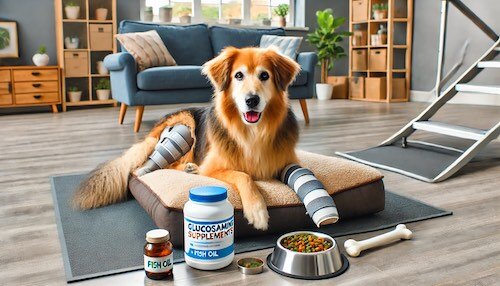
Arthritis in Dogs: Effective Treatments to Relieve Your Pet’s Pain
Arthritis is a prevalent and often debilitating condition that affects many dogs, particularly as they age. This degenerative joint disease can significantly impact your furry friend’s quality of life, causing pain, stiffness, and decreased mobility. Witnessing your beloved pet struggle with the discomfort of arthritis is heart-wrenching, but understanding the condition and knowing the available treatments can make a world of difference.
Search: Best Hip and Joint Supplements for Dogs
In this comprehensive guide, we delve into the various aspects of arthritis in dogs, from its causes and symptoms to the latest treatment options and lifestyle modifications that can help manage the condition. We’ll explore conventional medical treatments, such as NSAIDs and corticosteroids, as well as alternative therapies like acupuncture and hydrotherapy. Additionally, we’ll discuss the importance of nutritional management, weight control, and creating a comfortable environment to alleviate your dog’s pain.
Our aim is to equip you with the knowledge and tools needed to provide effective relief for your pet, ensuring they can enjoy a more active and comfortable life despite their arthritis. By taking a proactive approach and working closely with your veterinarian, you can develop a personalized treatment plan tailored to your dog’s specific needs, helping them navigate their golden years with less pain and more joy.
Understanding Arthritis in Dogs
Arthritis, also known as osteoarthritis or degenerative joint disease, is a progressive condition characterized by the deterioration of cartilage in the joints. This vital cartilage acts as a cushion between bones, ensuring smooth and pain-free movement. However, when this cartilage wears down, it leads to bone-on-bone contact, causing significant pain, inflammation, and decreased mobility. Arthritis can affect any joint in a dog’s body but is most commonly seen in the hips, knees, elbows, and spine.
Causes of Arthritis in Dogs
Several factors contribute to the development of arthritis in dogs, making it a multifaceted condition that requires a comprehensive understanding.
Age
As dogs age, their risk of developing arthritis increases. This is due to the natural wear and tear on their joints over time. Senior dogs often exhibit signs of arthritis as the cartilage that cushions their joints degenerates.
Genetics
Genetics plays a significant role in predisposing certain breeds to arthritis. Breeds such as Labrador Retrievers, German Shepherds, and Golden Retrievers are particularly susceptible due to their genetic makeup, which often includes predispositions to joint abnormalities and rapid growth phases that stress the joints.
Injury
Previous injuries or trauma to the joints, such as fractures or ligament tears, can increase the risk of developing arthritis. These injuries often lead to irregular joint surfaces or instability, accelerating the wear and tear process on the cartilage.
Obesity
Excess weight significantly contributes to arthritis by putting additional strain on the joints. Obesity not only exacerbates the wear and tear on joint cartilage but also increases inflammation, which can speed up the degenerative process.
Infection
Joint infections can lead to inflammation and damage to the cartilage. Conditions such as septic arthritis, caused by bacterial infection, can directly harm the joint structure, leading to long-term issues if not promptly treated.
Other Contributing Factors
- Poor Nutrition: Diets lacking essential nutrients can weaken the overall health of joints.
- Hormonal Imbalances: Conditions like hypothyroidism can indirectly affect joint health by influencing weight gain and energy levels.
- Autoimmune Disorders: Some dogs suffer from autoimmune diseases that attack their own cartilage.

Symptoms of Arthritis in Dogs
Recognizing the symptoms of arthritis in dogs is crucial for early intervention and effective management. Dogs are adept at hiding pain, so it’s essential to be vigilant and proactive.
Limping or Lameness
One of the most common signs of arthritis is limping or lameness. Dogs with arthritis may favor one leg over another or show an irregular gait, especially after periods of rest or intensive activity.
Stiffness
Stiffness is often most noticeable after rest or sleep. Dogs may struggle to move smoothly and may take longer to “warm up” after periods of inactivity.
Decreased Activity
A reluctance to walk, run, or play can indicate joint pain. Dogs with arthritis often show decreased enthusiasm for activities they previously enjoyed, such as fetching a ball or going for long walks.
Difficulty Rising or Lying Down
Dogs with arthritis may struggle to get up or lie down comfortably. You might notice your dog taking longer to rise, needing to shift position multiple times before settling, or showing signs of discomfort when trying to find a comfortable resting position.
Behavioral Changes
Increased irritability, depression, or a decrease in appetite can be signs of pain. Dogs may become less social, avoiding interactions that could lead to painful movement, and their mood can be significantly affected by chronic pain.
Swelling
Inflamed joints may appear swollen and warm to the touch. This swelling is due to the body’s inflammatory response to joint damage and can be a clear visual indicator of arthritis.
Muscle Atrophy
Reduced muscle mass around the affected joints due to decreased use is another symptom. Dogs with arthritis may show noticeable thinning of muscles, especially in their legs and hips, as they avoid using painful joints.
Additional Symptoms
- Popping or Grinding Noise: You may hear a popping or grinding noise (crepitus) when your dog moves the affected joint.
- Unusual Sitting Posture: Dogs may sit with their legs splayed out or in other unusual positions to alleviate pressure on painful joints.
- Frequent Licking of Joints: Dogs may lick or chew at their joints in response to pain and discomfort.
Diagnosing Arthritis in Dogs
If you suspect your dog has arthritis, a visit to the veterinarian is essential. Diagnosing arthritis involves a thorough assessment and a combination of diagnostic tools to ensure accurate identification and appropriate treatment planning.
Physical Examination
The vet will conduct a detailed physical examination to assess your dog’s gait, joint mobility, and pain response. They will observe how your dog moves and palpate (feel) the joints to detect swelling, warmth, and abnormal joint movement.
X-Rays
Imaging techniques like X-rays are crucial in diagnosing arthritis. X-rays can reveal joint abnormalities, cartilage loss, and bone spurs, providing a clear picture of the extent of joint damage and helping to differentiate arthritis from other potential causes of pain.
Joint Fluid Analysis
Analyzing the fluid in the joints, known as synovial fluid, can help identify inflammation and rule out other conditions. Joint fluid analysis can detect infections, crystal formation, and the degree of inflammation present in the joint.
Blood Tests
Blood tests can help rule out infections or other systemic conditions that might contribute to joint pain. They can also provide information on the overall health of your dog, including kidney and liver function, which is essential when considering long-term medication use.
Advanced Imaging Techniques
In some cases, advanced imaging techniques like MRI (Magnetic Resonance Imaging) or CT (Computed Tomography) scans may be necessary. These provide a more detailed view of the joint structures and can help identify subtle changes that are not visible on X-rays.
Arthroscopy
Arthroscopy is a minimally invasive procedure where a small camera is inserted into the joint to directly visualize the cartilage and other structures. This technique can provide definitive information about the state of the joint and help guide treatment decisions.
Conventional Treatments for Arthritis in Dogs
Managing arthritis in dogs typically involves a multifaceted approach, combining various treatments to alleviate pain, reduce inflammation, and improve joint function. Conventional treatments are often the first line of defense in managing this chronic condition.
Non-Steroidal Anti-Inflammatory Drugs (NSAIDs)
NSAIDs are commonly prescribed to reduce inflammation and alleviate pain. They work by inhibiting enzymes that contribute to inflammation. Some commonly used NSAIDs for dogs include carprofen, meloxicam, and deracoxib. While effective, long-term use of NSAIDs should be monitored by a veterinarian due to potential side effects such as gastrointestinal issues, liver or kidney damage, and bleeding disorders.
Pain Relief Medications
In addition to NSAIDs, other pain relief medications may be prescribed to manage chronic pain. These can include:
Gabapentin
Gabapentin is used for neuropathic pain and can help improve mobility. It works by stabilizing nerve activity, thereby reducing pain signals. It’s particularly useful for dogs with severe or persistent pain.
Tramadol
Tramadol is an opioid-like pain reliever that can be used for moderate to severe pain. It works by altering the brain’s perception of pain. While effective, it should be used with caution due to the potential for dependence and side effects such as sedation and gastrointestinal upset.
Amantadine
Amantadine is often used in combination with other pain relievers to enhance their effectiveness. It works by blocking certain receptors in the nervous system that are involved in pain signaling, providing an additional layer of pain control.
Corticosteroids
Corticosteroids are potent anti-inflammatory drugs that can provide relief from severe inflammation and pain. However, they are generally used for short-term management due to their potential side effects, including increased thirst and appetite, weakened immune system, and potential for long-term joint damage. They are typically reserved for cases where other treatments have not provided adequate relief.
Disease-Modifying Osteoarthritis Drugs (DMOADs)
DMOADs, such as polysulfated glycosaminoglycan (PSGAG), aim to protect and repair joint cartilage. These drugs can help slow the progression of arthritis and improve joint health. They are typically administered as injections and may be used in combination with other treatments. PSGAG works by inhibiting the enzymes that break down cartilage and promoting the production of new cartilage.
Hyaluronic Acid Injections
Hyaluronic acid injections can help lubricate the joints and improve mobility. This substance is naturally found in joint fluid and acts as a cushion and lubricant. Injections can provide temporary relief from pain and improve joint function, particularly in the early stages of arthritis.
Surgical Options
In severe cases, surgical intervention may be necessary. Options include joint replacement, arthroscopy to clean out the joint, or corrective surgery to realign the joint and reduce stress on the affected area. These procedures can be highly effective but are typically reserved for dogs that do not respond to other treatments.

Read More: Top 10 Dog Breeds With The Shortest Lifespans
Alternative and Complementary Therapies
In addition to conventional treatments, several alternative and complementary therapies can provide relief from arthritis symptoms and improve your dog’s overall well-being. These therapies can be used in conjunction with traditional treatments to create a comprehensive arthritis management plan.
Acupuncture
Acupuncture involves inserting thin needles into specific points on the body to stimulate nerve endings and promote healing. It can help reduce pain and inflammation and improve joint function. Many dogs tolerate acupuncture well, and it can be used alongside other treatments for a holistic approach to arthritis management. Acupuncture can also help improve blood flow and stimulate the release of natural pain-relieving chemicals in the body.
Physical Therapy and Hydrotherapy
Physical therapy can help maintain or improve joint mobility and muscle strength. Techniques may include passive range-of-motion exercises, stretching, and controlled walking. Hydrotherapy, or water therapy, allows dogs to exercise without putting weight on their joints. Swimming or walking on an underwater treadmill can enhance muscle strength and joint flexibility. The buoyancy of the water reduces stress on the joints while providing resistance to build muscle.
Massage Therapy
Massage therapy can help relieve muscle tension, improve circulation, and reduce pain. Regular massages can also promote relaxation and enhance your dog’s overall well-being. A professional canine massage therapist can tailor sessions to address specific areas of discomfort. Massage can also help break down scar tissue, improve flexibility, and reduce stress hormones in the body.
Laser Therapy
Low-level laser therapy, also known as cold laser therapy, uses light energy to stimulate cell regeneration and reduce inflammation. This non-invasive treatment can help alleviate pain and improve mobility in dogs with arthritis. Laser therapy sessions are typically quick and painless, making them a convenient option for many pet owners. The light energy penetrates deep into tissues, promoting healing at the cellular level and reducing pain.
Chiropractic Care
Chiropractic care involves the manipulation of the spine and joints to improve alignment and relieve pain. This treatment can help restore normal joint function and reduce the stress on arthritic joints. Chiropractic adjustments can be particularly beneficial for dogs with spinal arthritis or those who have developed compensatory issues due to joint pain.
Nutritional Management and Supplements
Diet and nutrition play a crucial role in managing arthritis in dogs. Certain nutrients and supplements can help reduce inflammation, support joint health, and improve your dog’s overall condition.
Omega-3 Fatty Acids
Omega-3 fatty acids, commonly found in fish oil, have anti-inflammatory properties that can help reduce joint pain and stiffness. Supplementing your dog’s diet with omega-3 fatty acids can improve mobility and decrease the need for pain medications. These fatty acids also support overall cardiovascular health and immune function.
Glucosamine and Chondroitin
Glucosamine and chondroitin are natural compounds found in healthy cartilage. These supplements can help protect and repair joint cartilage, reducing pain and improving joint function. They are often available in combination supplements designed specifically for dogs. Regular supplementation can help slow the progression of arthritis and maintain joint health.
Green-Lipped Mussel
Green-lipped mussel (GLM) is a natural source of omega-3 fatty acids, glucosamine, and chondroitin. It also contains unique compounds that have anti-inflammatory and joint-protective properties. GLM supplements can help improve joint health and reduce arthritis symptoms in dogs. The anti-inflammatory effects of GLM can also benefit skin and coat health.
Antioxidants
Antioxidants such as vitamins C and E can help reduce oxidative stress and inflammation in the joints. Including antioxidant-rich foods or supplements in your dog’s diet can support overall joint health and enhance the effectiveness of other treatments. These antioxidants help neutralize free radicals that can damage cells and tissues, promoting overall health and longevity.
Other Beneficial Supplements
- MSM (Methylsulfonylmethane): This supplement helps reduce inflammation and pain and supports the maintenance of healthy connective tissue.
- Turmeric/Curcumin: Known for its powerful anti-inflammatory properties, turmeric can be included in your dog’s diet to help manage arthritis symptoms.
- Boswellia: An herbal supplement that can reduce inflammation and pain in the joints.
Lifestyle Modifications
In addition to medical treatments and supplements, making certain lifestyle modifications can significantly impact your dog’s arthritis management and overall well-being.
Weight Management
Maintaining a healthy weight is crucial for dogs with arthritis. Excess weight puts additional stress on the joints, exacerbating pain and inflammation. Work with your veterinarian to develop a weight management plan that includes a balanced diet and appropriate exercise. Regular monitoring of your dog’s weight and adjusting their diet as needed can help manage their arthritis more effectively.
Exercise and Mobility Aids
Regular, low-impact exercise can help maintain joint mobility and muscle strength. Activities such as short walks, swimming, and gentle play can be beneficial. Avoid high-impact activities that could worsen joint damage. Additionally, consider using mobility aids such as ramps, harnesses, and orthopedic beds to make daily activities easier for your dog. Providing steps or ramps for getting onto furniture and into cars can also reduce strain on your dog’s joints.
Creating a Comfortable Environment
Making your home more comfortable for your arthritic dog can significantly improve their quality of life. Provide soft bedding in easily accessible areas, and use non-slip mats to prevent falls on slippery surfaces. Ensure your dog has easy access to food, water, and outdoor areas to minimize unnecessary strain on their joints. Creating a warm, draft-free sleeping area and elevating food and water bowls can also help reduce discomfort.
Regular Grooming and Nail Trimming
Regular grooming and keeping your dog’s nails trimmed can help maintain their comfort and mobility. Long nails can alter the way your dog walks, adding strain to their joints, while regular grooming can keep their coat clean and free of mats, which can affect skin health and comfort.
Joint-Friendly Playtime
Engage your dog in joint-friendly play activities that promote movement without excessive strain. Interactive toys that encourage gentle play and puzzle feeders that stimulate their mind while limiting physical exertion can be great options.
Preventive Measures
While arthritis is not always preventable, there are steps you can take to reduce the risk and promote joint health in your dog.
Early Detection
Regular veterinary check-ups can help detect early signs of arthritis before they become severe. Early intervention can slow the progression of the disease and improve your dog’s prognosis. Be proactive in discussing any changes in your dog’s behavior or mobility with your vet.
Regular Vet Check-Ups
Regular visits to the veterinarian are essential for monitoring your dog’s joint health and adjusting treatment plans as needed. Your vet can provide guidance on preventive measures, lifestyle modifications, and early intervention strategies. These check-ups are also an opportunity to discuss the effectiveness of current treatments and make necessary adjustments.
Joint Health Maintenance
Maintaining your dog’s joint health through a combination of diet, exercise, and preventive measures can help reduce the risk of arthritis. Consider providing joint supplements, ensuring regular physical activity, and avoiding activities that could cause joint injuries. Early intervention with joint-protective measures, such as providing a high-quality diet rich in joint-supporting nutrients and maintaining an appropriate weight, can also play a significant role in preventing arthritis.
Breeding Practices
If you are a breeder or considering breeding your dog, pay attention to genetic factors that influence joint health. Avoid breeding dogs with known joint issues to reduce the risk of passing these conditions to future generations.
Environmental Enrichment
Providing a stimulating environment with plenty of mental and physical activities can keep your dog engaged and active. Mental enrichment can reduce stress and promote overall well-being, indirectly benefiting joint health.
Conclusion
Arthritis in dogs is a challenging condition, but with the right approach, you can significantly improve your pet’s quality of life. By understanding the causes, symptoms, and available treatments, you can make informed decisions to manage your dog’s arthritis effectively. Combining conventional treatments with alternative therapies, nutritional management, lifestyle modifications, and preventive measures can provide comprehensive care and help your dog live a happier, more comfortable life.
Remember, every dog is unique, and what works for one may not work for another. Work closely with your veterinarian to develop a personalized treatment plan tailored to your dog’s specific needs. With patience, dedication, and the right care, you can help your furry friend enjoy their golden years with less pain and more joy. Ensuring your dog remains active, comfortable, and healthy is the ultimate goal, and with the wealth of treatment options available, there is hope for managing arthritis effectively.
